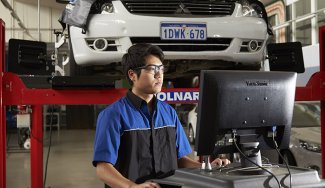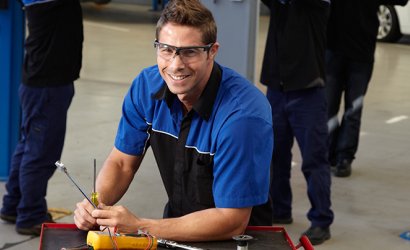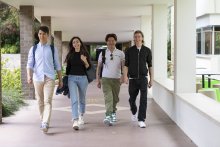

Why choose this course?
Enter the automotive service and repair industry with this qualification. This course teaches you a broad range of skills that can be performed on light vehicles such as how to inspect and service engines; how to test, charge and replace batteries; and how to jump start vehicles and carry out general servicing operations using specific tools and equipment.
You will also gain skills to inspect, diagnose, service or repair various components of light vehicles such as hydraulic brakes, steering and suspension systems, automotive electrical systems and circuits, clutch systems, vehicle drive shafts, manual and automatic transmissions, ignition and starting systems, cooling systems, emission control systems and fuel systems.
As part of this course you will be supplied with personal protective clothing and equipment such as uniforms and industry approved footwear. These items will be purchased by the college on your behalf, for you to keep. The cost of these items is covered as part of the resource fees charged by the college. There is no need for you to pre-purchase these items before you commence the course.
International students cannot study this course as an indentured apprentice. The course is delivered in a simulated work environment and registration as an apprentice is not available to international students.
After completion of this course you can further your studies with the AUR40216 Certificate IV in Automotive Mechanical Diagnosis.
Career opportunities
- Light Vehicle Mechanical Technician
-
An IELTS score (academic) of 6.0 with no band score less than 5.0 or equivalent.
-
Equivalent to Australian Year 11 with passes in Maths is required for entry into this course.
There may be further semester intakes available for enrolment. You can view any further intakes when you submit your online application(opens in a new tab).
For information about pathways from TAFE to university, view our Pathways to university page.
How to apply
Apply to study at TAFE in six steps:
- find a course;
- check entry requirements;
- submit an application;
- accept your offer and pay;
- apply for your student visa; and
- receive your visa and come to Australia for your studies.
Build your own course guide
Select the study areas, courses and topics you like. Get your custom guide by email!
Download study area guide(opens in a new tab)
Contact us(opens in a new tab)
TAFE International Western Australia (TIWA) is the Registered Training Organisation (RTO) and Commonwealth Register of Institutions and Courses for Overseas Students (CRICOS) provider, for the delivery of training to international students, enrolled in a TAFE course in Western Australia. This nationally recognised course is delivered by a Western Australian TAFE college on TIWA's behalf. TIWA retains responsibility for the quality of the training and assessment delivered by the TAFE colleges and for the issue of certification documentation to students.

